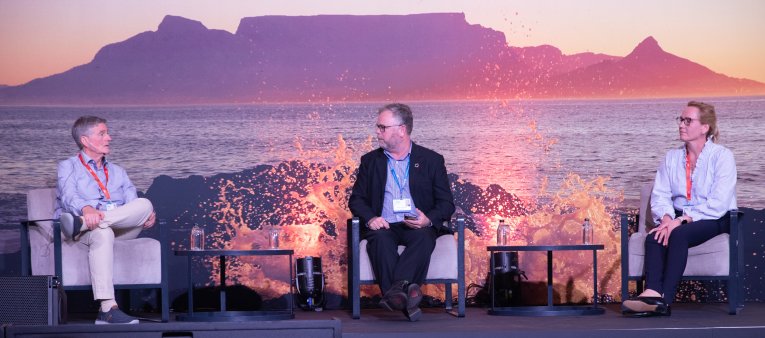The Annual Conference's Challenges and Opportunities session, chaired by Dr Brett Glencross, IFFO's Technical Director, on 24 October, dives into two key technical topics: precision nutrition and omega-3s.
What is precision nutrition?
 The industry has evolved greatly over recent decades and is now entering an era of knowledge based precision nutrition. "This concept takes into account broader elements of production performance and sustainability criteria, but in particular focuses on the precise definition of nutrient and energy supply and the feed design specifications required to deliver that", according to Dr Jorge Dias (Sparos Lda). Formulators need to cover the requirements of all essential nutrients (40), promote the well-being of the animals, ensure good feed intake and now also incorporate carbon-footprint metrics.
The industry has evolved greatly over recent decades and is now entering an era of knowledge based precision nutrition. "This concept takes into account broader elements of production performance and sustainability criteria, but in particular focuses on the precise definition of nutrient and energy supply and the feed design specifications required to deliver that", according to Dr Jorge Dias (Sparos Lda). Formulators need to cover the requirements of all essential nutrients (40), promote the well-being of the animals, ensure good feed intake and now also incorporate carbon-footprint metrics.
Precision nutrition is needed for a range of reasons: it allows for a judicious use of strategic ingredients to be made, hence avoiding over formulation; it helps control variations in raw material quality; and it guarantees a high quality feed, as well as a low feed conversion ratio (FCR).
Fishmeal, fish oil supply has been stable over the last decades and are now seen as strategic/functional ingredients as they bring benefits beyond the coverage of nutritional requirements. Marine ingredients are often used in the early growth stages, but this fluctuates from region and species. Taking a closer look at the optimal range of amino acids, in terms of protein digestibility but also the metabolic protein use, is key to focusing on relevant nutrient costs. The industry needs to continue refining its optimisation of nutrient specifications and targeting those ingredients that bring benefits beyond basic nutrient supply. This includes increasing the range of ingredients available and focusing on more efficient feeds through more precisely defining what animals need. "The industry needs to do better with the existing resources, focus on emerging trends and rising challenges".
Filling the data gaps in marine ingredients
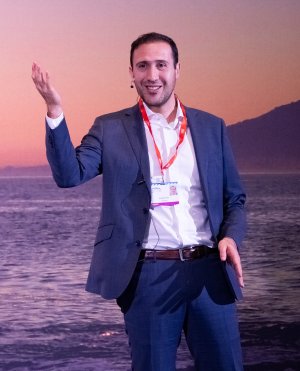 Continuing with the environmental perspectives on feed, but now focusing on lifecycle assessment (LCA) data gaps, Skretting’s Jorge Diaz Salinas raised awareness on what data is needed to carry out LCA following the appropriate Product Environmental Footprint Category Rules (PEFCR), which give clear guidelines to the feed industry. Skretting needs this data as it is required by regulators, feed customers are increasingly asking for this data, the retailers are now demanding this information through science-based targets; and lastly it is needed to comply with certifications. The Global Feed Lifecycle assessment Institute (GFLI) has rough average data for fishmeal/oil from 10 countries, with specific data for 15 different species (13 whole fish/3 trimmings) mainly from Norway, Peru, Mexico, and the US. Marine ingredient suppliers need to work on their own primary data and there are many gaps that the industry needs to fill.
Continuing with the environmental perspectives on feed, but now focusing on lifecycle assessment (LCA) data gaps, Skretting’s Jorge Diaz Salinas raised awareness on what data is needed to carry out LCA following the appropriate Product Environmental Footprint Category Rules (PEFCR), which give clear guidelines to the feed industry. Skretting needs this data as it is required by regulators, feed customers are increasingly asking for this data, the retailers are now demanding this information through science-based targets; and lastly it is needed to comply with certifications. The Global Feed Lifecycle assessment Institute (GFLI) has rough average data for fishmeal/oil from 10 countries, with specific data for 15 different species (13 whole fish/3 trimmings) mainly from Norway, Peru, Mexico, and the US. Marine ingredient suppliers need to work on their own primary data and there are many gaps that the industry needs to fill.
Raw materials used in the feed are the main driver of emissions by the feed sector and tracking and reduction of that footprint can only be achieved with the correct data. In order to calculate carbon footprint, water footprint, and all the other footprints required as part of the LCA process, data is needed from various stages in the ingredient production process, including catching, transport, processing and storage. The information required includes such detail as the types of vessels used, their construction, the use of refrigerants, and fuel used in the fishing operation, and this is all before we consider what happens once the fish comes ashore for the fishmeal and oil production process. "Marine ingredients have a low carbon footprint compared with terrestrial ingredients. They represent 10% of Skretting's carbon footprint. However, we need a more holistic view taking other parameters into account, such as biodiversity impacts".
Why where something comes from matters
 The need for data was echoed by Dr Wesley Malcorps, (Institute of Aquaculture, University of Stirling), who explored how understanding where and how seafood is produced is crucial to verify the status of those raw materials in relation to laws on food safety and production practices. But this information is also critical for the LCA story as raw material origin plays a big part in how environmental burdens are allocated. “We need to first define what sustainability is and decide on what we want to achieve first. Sustainability is a journey, not an endpoint and saying that something is sustainable can limit further improvements”. Sustainability is not just about the environment, but includes many aspects, such as social and economic aspects as well as fish welfare indicators. If we don’t include them all, we are not really talking about sustainability.
The need for data was echoed by Dr Wesley Malcorps, (Institute of Aquaculture, University of Stirling), who explored how understanding where and how seafood is produced is crucial to verify the status of those raw materials in relation to laws on food safety and production practices. But this information is also critical for the LCA story as raw material origin plays a big part in how environmental burdens are allocated. “We need to first define what sustainability is and decide on what we want to achieve first. Sustainability is a journey, not an endpoint and saying that something is sustainable can limit further improvements”. Sustainability is not just about the environment, but includes many aspects, such as social and economic aspects as well as fish welfare indicators. If we don’t include them all, we are not really talking about sustainability.
Traceability is a key part of this if we want to understand where things come from, how we are moving things forward, and transferring that information along the supply chain to stakeholders and final consumers. Businesses need to identify key data elements and who needs them, including the end consumers to inform their choices and drive market change. Feeds perform differently depending on the impact categories used and companies need to understand the trade-offs between these different environmental and social impacts, and marine and terrestrial environments. “We are interested in marine ingredients, and they have a low carbon footprint compared to plant ingredients. However, if we are going to produce more sustainable marine ingredients, we need to use more by-products. Traceability is crucial to ensure that the by-product resources are from safe and sustainable resources.”
The use of a shared network along the supply chain is the way forward. This could be done by using IoT devices, with a trusted database that is not managed by a single authority, immutable, decentralized and hard to hack. It is important to note, that in a shared network, participants need incentives to share data, and they need to feel that protected, and that they are not being monitored.
What Omega-3's do in Humans
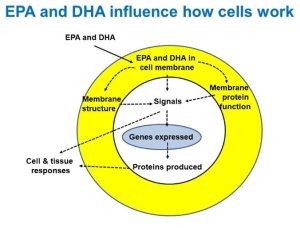 Moving our focus to human nutrition, Professor Philip Calder (University of Southampton) explored the lessons learned from human omega-3 physiology. EPA and DHA provide special and unique biological properties to humans, changing the physicality of the membrane and its function, changing protein and lipid function and structure in a more optimal way. This changes gene expression patterns, altering when proteins are produced, cell responses and activation, and “raft” assembly in the cell membrane, which affects the way in which proteins and cell membranes function. The overall benefit varies among the different organs throughout the body, including aiding visual function, cognitive function, metabolism, inflammation regulation, immune responses, oxidative stress, blood coagulation, organ function (e.g. Heart, Liver, Lung, Muscle), and wound healing.
Moving our focus to human nutrition, Professor Philip Calder (University of Southampton) explored the lessons learned from human omega-3 physiology. EPA and DHA provide special and unique biological properties to humans, changing the physicality of the membrane and its function, changing protein and lipid function and structure in a more optimal way. This changes gene expression patterns, altering when proteins are produced, cell responses and activation, and “raft” assembly in the cell membrane, which affects the way in which proteins and cell membranes function. The overall benefit varies among the different organs throughout the body, including aiding visual function, cognitive function, metabolism, inflammation regulation, immune responses, oxidative stress, blood coagulation, organ function (e.g. Heart, Liver, Lung, Muscle), and wound healing.
Omega-3 Requirements in Fish: Critical vs Desirable
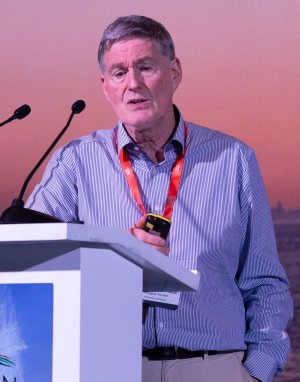 The benefits of EPA and DHA to humans are quite similar for fish, hence the focus on their inclusion in feed. Professor Douglas Tocher (University of Shantou) presented the evolution of aquafeed and noted that farmed fish diets focus on high energy (fat/lipid) diets to promote growth (protein sparing). However, increasing use terrestrial plant raw materials, like rapeseed oil, is increasing 18:2n-6 content and altering the n-6/n-3 ratio of feeds. Most research into impacts on essential fatty acid requirements focuses on Atlantic salmon and is based on the scale of salmon farming, with a focus on the importance of fish oil in salmon feeds.
The benefits of EPA and DHA to humans are quite similar for fish, hence the focus on their inclusion in feed. Professor Douglas Tocher (University of Shantou) presented the evolution of aquafeed and noted that farmed fish diets focus on high energy (fat/lipid) diets to promote growth (protein sparing). However, increasing use terrestrial plant raw materials, like rapeseed oil, is increasing 18:2n-6 content and altering the n-6/n-3 ratio of feeds. Most research into impacts on essential fatty acid requirements focuses on Atlantic salmon and is based on the scale of salmon farming, with a focus on the importance of fish oil in salmon feeds.
In the last 20-25 years, salmon feed formulations dominated by increased dietary lipid (fat) content and increased n-6/n-3 PUFA ratio. In farmed salmon, omega-3 LC-PUFA requirements range between 5 to 8 % of total fatty acids (TFA) in ‘laboratory’ conditions (1-3 % of diet). However, in challenging (farm) conditions the specific EPA and DHA requirements are closer to 10 % TFA (about 2% to 3.5 % of diet). Inclusion levels differ greatly in marine species and are impacted by the n-6/n-3 PUFA balance, and environmental challenges.
Looking beyond EPA and DHA.
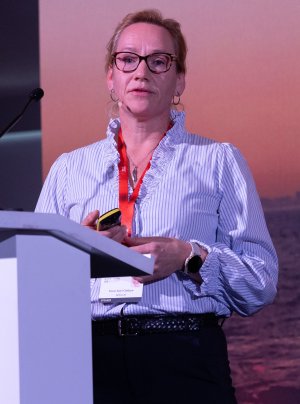 Nofima scientist Tone-Kari Ostbye then took a deep dive into the world of long chain mono-unsaturated fatty acids (LC-MUFAs) and very long chain polyunsaturated fatty acids (VLC-PUFAs). These are fatty acids found in various types of fish oils depending on factors such as species, season, age, geographical location and physiological status. Only a minor part of the fish oils constitutes VLC-PUFAs (ca. 0.5% of the total fatty acids), which are fatty acids with a chain length of ≥ 24 carbon atoms. The physiological roles of these VLC-PUFAs are not completely understood, but recent studies suggest functions in tissues such as brain, skin, testis and eye. LC-MUFAs on the other hand are fatty acids with between 18-24 carbon atoms. The known functions of LC-MUFAs are linked to increased fat oxidation, improved omega-3 fatty acid synthesis and reduction of inflammation, but the mechanisms are unknown. The research so far indicates that the VLC-PUFA and LC-MUFA have a wide range of physiological functions in the body of importance to health, and fish oils are valuable sources of these fatty acids.
Nofima scientist Tone-Kari Ostbye then took a deep dive into the world of long chain mono-unsaturated fatty acids (LC-MUFAs) and very long chain polyunsaturated fatty acids (VLC-PUFAs). These are fatty acids found in various types of fish oils depending on factors such as species, season, age, geographical location and physiological status. Only a minor part of the fish oils constitutes VLC-PUFAs (ca. 0.5% of the total fatty acids), which are fatty acids with a chain length of ≥ 24 carbon atoms. The physiological roles of these VLC-PUFAs are not completely understood, but recent studies suggest functions in tissues such as brain, skin, testis and eye. LC-MUFAs on the other hand are fatty acids with between 18-24 carbon atoms. The known functions of LC-MUFAs are linked to increased fat oxidation, improved omega-3 fatty acid synthesis and reduction of inflammation, but the mechanisms are unknown. The research so far indicates that the VLC-PUFA and LC-MUFA have a wide range of physiological functions in the body of importance to health, and fish oils are valuable sources of these fatty acids.
Is fish oil just an omega-3 source? This was the key focus of the panel session, moderated by Dr Brett Glencross, featuring Tone-Kari Ostbye and Douglas Tocher.
There are many different fatty acids in fish, which are not just an energy source: including long chain mono-unsaturated fatty acids (LC-MUFAs) and very long chain polyunsaturated fatty acids (VLC-PUFAs). These are fatty acids found in various types of fish oils. “EPA and DHA are all very biologically active molecules. Their mechanism is well known when it comes to modulating the anti-inflammatory response. The other aspects are less well known”, said Doug Tocher. These fatty acids have some very positive effects on the skin, including some important influences on wound healing that has been explored by Nofima in its salmon studies. The main impact appears to be linked to the anti-inflammatory responses that these molecules confer.
Is it the same to eat fish rich in omega-3 or to take omega-3 supplements? “Digestibility is the first criteria to look at. The issue with fish oil capsules is that you should take them with food to stimulate the digestion process. Once EPA and DHA have been digested and absorbed in the body, there may be no difference” according to the panellists.
